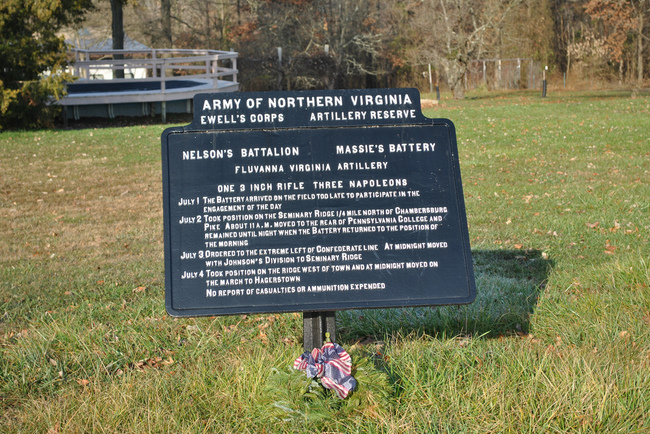A Brief History of the two batteries that bore the title of Fluvanna
Fluvanna County was proud to organize two light artillery batteries in the spring of 1861. After being trained at Richmond, the two units were sent to Manassas and were assigned to the reserve artillery. They did not see action until the beginning of the Seven Days Battles, and even then were engaged only sporadically. The “Sons of Fluvanna” (1st Battery), commanded by Capt. Charles Huckstep, and the “Fluvanna Light Artillery” (2nd Battery), commanded by Captain John J. Ancell, missed the battles of Second Manassas and Antietam, though Huckstep’s command lost a gun and a caisson at Shepherdstown on September 19, 1862.
The 1st and 2nd Fluvanna Batteries were consolidated in early October 1862 as part of Lee’s program to revitalize his artillery. The Fluvanna Consolidated Artillery was present but not heavily engaged at Fredericksburg, Chancellorsville and Gettysburg as part of Nelson’s reserve battalion. Its heaviest losses during this span occurred at the lesser known engagement at Waterloo, Pennsylvania, during the retreat from Gettysburg, and at Kelly’s Ford that fall.
The last twelve months of the war brought the Fluvanna Artillery into the center of the action. Commanded by Captain John L. Massie, the battery was heavily engaged from the Wilderness to Cold Harbor and became one of Early’s most reliable units from Monocacy to Cedar Creek. This heavy campaigning cost the battery almost fifty combat casualties, including Captain Massie who was mortally wounded at Tenth Legion Church on September 24, 1864. Captain Charles G. Snead led the remnants of the brave battery, who were barely enough men to man two guns, until the unit was captured at Waynesboro on March 2, 1865.
About the Huckstep’s 1st Fluvanna Virginia Battery
From the roster in the back of the book, “The Fluvanna Artillery”, by David G. Martin, part of The Virginia Regimental Histories Series, copyright 1992, H.E. Howard, Inc., Lynchburg, VA (ISBN-1-56190-037-0) — page 159 & 160:
“The activities of the Fluvanna Artillery have been given much importance by some researchers and somewhat lesser importance by others. The following is a brief history of The Fluvanna Artillery from the above referenced book:
“Fluvanna County was proud to organize two light artillery batteries in the spring of 1861. After being trained at Richmond, the two units were sent to Manassas and were assigned to the reserve artillery. They did not see action until the beginning of the Seven Days Battles, and even then were engaged only sporadically. The “Sons of Fluvanna” (1st Battery), commanded by Capt. Charles Huckstep, and the “Fluvanna Light Artillery” (2nd Battery), commanded by Captain John J. Ancell, missed the battles of Second Manassas and Antietam, though Huckstep’s command lost a gun and a caisson at Shepherdstown on September 19, 1862.
The 1st and 2nd Fluvanna Batteries were consolidated in early October 1862 as part of Lee’s program to revitalize his artillery. The Fluvanna Consolidated Artillery was present but not heavily engaged at Fredericksburg, Chancellorsville and Gettysburg as part of Nelson’s battalion. Its heaviest losses during this span occured at the lesser known engagement at Waterloo, Pennsylvania, during the retreat from Gettysburg, and at Kelly’s Ford that fall.
The last twelve months of the war brought the Fluvanna Artillery into the center of the action. Commanded by Captain John L. Massie, the battery was heavily engaged from the Wilderness to Cold Harbor and became one of Early’s most reliable units from Monocacy to Cedar Creek. This heavy campaigning cost the battery almost fifty combat casualties, including Captain Massie who was mortally wounded at Tenth Legion Church on September 24, 1864. Captain Charles G. Snead led the remnants of the brave battery, who were barely enough men to man two guns, until the unit was captured at Waynesboro on March 2, 1865.”
Information regarding the Fluvanna Artillery, Massie’s Company and Nelson’s Battalion is common and extensive in Civil War books. Additionally, in 1910, two artillery guns were placed and marked at Gettysburg in the approximate location of Massie’s Company during Pickett’s Charge during the second day of the infamous battle.

